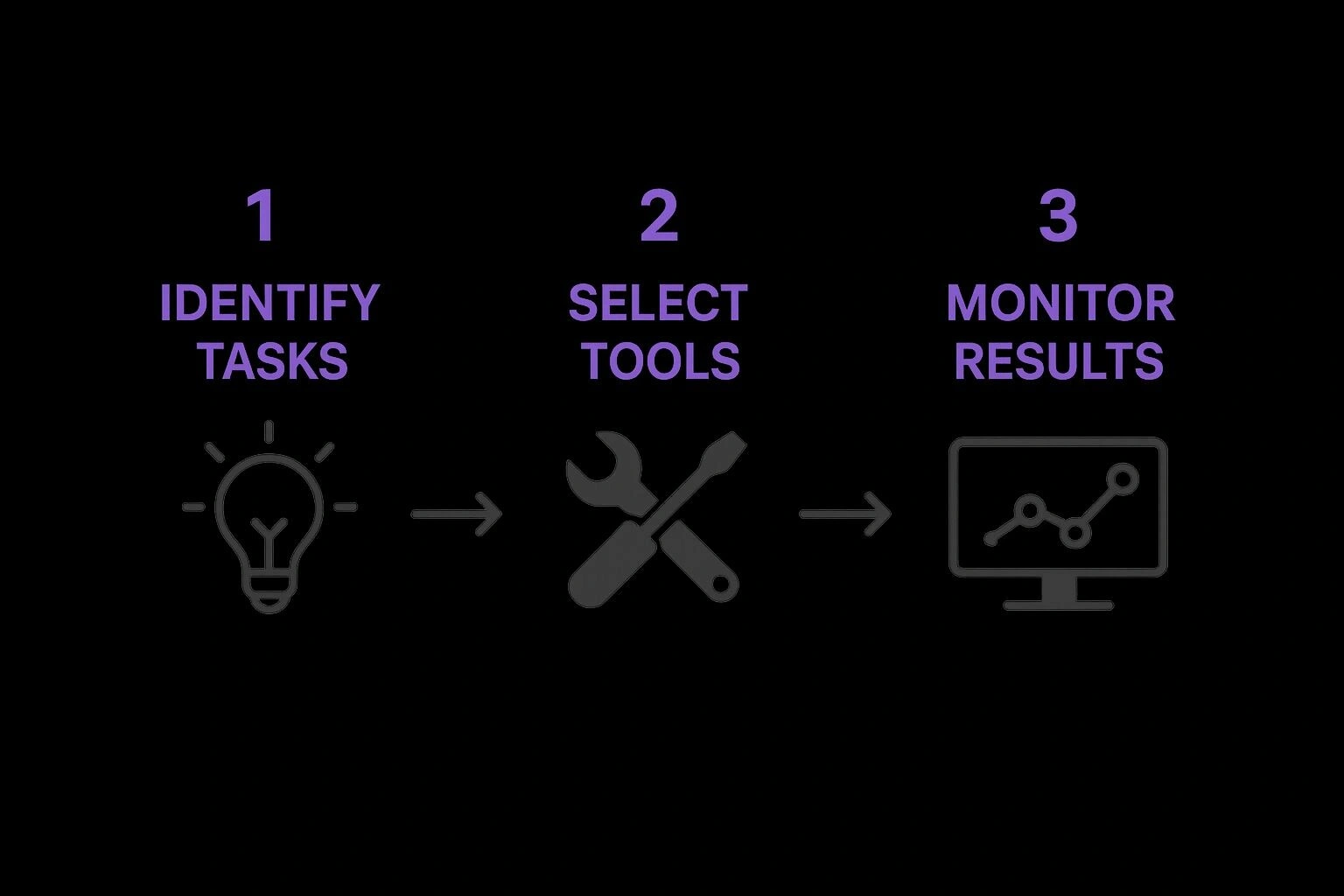Scaling Business Processes for Sustainable Growth
A practical guide to scaling business processes with AI and RPA. Learn to overcome constraints, choose the right tech, and drive profitable growth.

Growing your business isn’t just about hiring more people. That’s a trap. True scalability comes from designing a blueprint for growth that can handle more demand without piling on proportional costs. It’s a strategic shift, focusing on rooting out inefficiencies and smartly applying technology like automation to build workflows that are ready for whatever comes next.
Building a Foundation for Scalable Growth

Before you even think about shopping for AI tools or automation software, you need to look inward. Seriously. Trying to scale on top of shaky or inefficient processes is like building a skyscraper on a foundation of sand—it only amplifies the existing cracks and leads to wasted money and infuriating roadblocks.
The first, non-negotiable step is a thorough audit of your current operations. This isn’t a quick glance; it’s a deep, analytical dive into every single workflow. We’re talking about tracing the entire journey from the moment a new lead pops up in your system to the final invoice getting paid. Your goal is to create a detailed, honest map of how your business actually runs.
Mapping Your Core Processes
Start by documenting the handful of processes that are the lifeblood of your business. Think about the entire customer experience and all the internal work that makes it happen.
Your list will probably look something like this:
- Lead Generation & Nurturing: How do we find, capture, and qualify people who might buy from us?
- Sales & Quoting: What are the exact steps to build a proposal and get a signature?
- Client Onboarding: How do we roll out the red carpet for a new customer and get them started?
- Service Delivery: What’s the A-to-Z workflow for delivering what we sold?
- Invoicing & Payments: How do we bill for our work and manage the money coming in?
For each one, get granular. Who does what? Which software is involved? How long does it really take? This detailed mapping is often an eye-opener, immediately exposing redundant steps and manual tasks that are begging to be optimised.
A classic mistake is thinking you know how a process works without mapping it out. I’ve seen it time and again: the “official” process in a handbook is worlds away from the daily workarounds your team uses to just get the job done.
Identifying Bottlenecks and Opportunities
Once you have these process maps laid out, the problem areas start to jump off the page. You’re looking for the tasks that are repetitive, soul-crushingly time-consuming, or magnets for human error. These are your low-hanging fruit for automation.
Don’t forget the people-problems, either. To build a truly scalable foundation, you have to plan for growth, and that includes tackling the common hiring challenges for companies scaling their operations. If only one person in the entire company knows how to do a critical task, you’ve just identified a massive business risk.
To help structure this analysis, I use a simple framework. It forces you to ask the right questions and quantify the real impact of sticking with the status quo.
Process Assessment Framework Key Areas
This table summarises the critical areas to evaluate when you’re assessing your business processes for scalability and automation potential.
| Assessment Area | Key Questions to Ask | Potential Impact of Inefficiency |
|---|---|---|
| Time & Effort | How many hours are spent on this task weekly/monthly? Is it repetitive? | High labour costs, employee burnout, slow turnaround times. |
| Error Rate | How often do mistakes happen here? What’s the cost of fixing them? | Rework, customer dissatisfaction, compliance risks. |
| Dependencies | Does this process rely on a single person or tool? What happens if they’re unavailable? | Single point of failure, operational bottlenecks, project delays. |
| Scalability | What would happen if we had 10x the volume? Could the current process handle it? | Inability to grow, service quality degradation, missed revenue. |
| Data Quality | Is the data generated or used in this process accurate and consistent? | Poor decision-making, flawed reporting, wasted marketing spend. |
This diagnostic phase isn’t about blaming people or past decisions. It’s about creating a clear, actionable plan. By zeroing in on the biggest drains on your time, money, and morale, you can prioritise the changes that will deliver the biggest wins, setting your business up for smart, sustainable growth.
Navigating and Overcoming Workforce Constraints
Your ability to scale is tied directly to your team’s capacity and skills. It’s a simple truth. You can map out the most brilliant processes on paper, but if you don’t have the right people to execute them, your growth will hit a wall. This isn’t just a hiring issue; it’s a fundamental, structural barrier to scaling your operations.
Talent shortages in key roles can stop ambitious growth plans dead in their tracks. We’ve all seen it happen. A process becomes so reliant on one or two key individuals that their absence—or worse, their departure—creates a bottleneck that ripples through the entire company. You can’t just throw more bodies at this problem, especially in a tight labour market.
This challenge is particularly acute across many Australian industries right now. Recent analysis paints a clear picture: labour market constraints are a major handbrake on scalability. The numbers speak for themselves. 28% of businesses have seen their operational efficiency drop due to staff shortages, and that gap directly stunts growth. In fact, 20% of companies admitted it blocked their business development, with another 10% feeling the financial pain. It’s a reality that forces a strategic pivot—from just finding more people to building more resilient systems.
Building a Resilient Workforce
The real solution is to design processes and systems that aren’t so dependent on specific individuals. This means proactively building resilience right into the fabric of your workforce structure. It’s about turning a vulnerability—that reliance on a few key people—into a genuine competitive advantage.
Here are a few strategies I’ve seen work well in practice:
- Targeted Upskilling Programs: Pinpoint the skills gaps that automation simply can’t fill, like complex problem-solving or high-level client strategy. Invest in training your existing team to step into these roles. This not only creates internal career paths but also keeps invaluable institutional knowledge from walking out the door.
- Fostering Adaptability: Make cross-training a standard practice, not a “nice-to-have.” When several team members can handle a critical task, you’ve immediately eliminated a single point of failure. It also gives you the flexibility to reassign people as your business priorities shift.
- Strategic Role Design: Take a hard look at which roles are ripe for automation and which ones truly need a human touch. This isn’t about replacing people; it’s about augmenting them.
Think of it this way: you don’t want a business that grinds to a halt just because your top salesperson takes a two-week holiday. A scalable system ensures leads are still qualified, quotes are still sent, and opportunities keep moving forward, regardless of who is at their desk.
Identifying Automation and Outsourcing Opportunities
Once you have a clear view of your workforce constraints, you can identify where technology or external partners can give you the most lift. The objective is to free up your core team from the repetitive, low-value tasks so they can focus on the work that actually moves the needle. For a more detailed look at this, our guide on how to improve operational efficiency offers practical steps that tie in perfectly here.
Start by asking which tasks are rules-based and repeatable. What are the daily or weekly activities that chew up hours but require very little strategic thinking? These are prime candidates for Robotic Process Automation (RPA). Things like data entry, generating standard reports, or initial lead sorting can often be automated completely.
For more complex but non-core functions—think payroll or IT helpdesk support—strategic outsourcing can provide expert capacity without the overhead of a full-time internal team. This approach ensures that when you do make a new hire, it’s for a role that directly contributes to what makes your business unique.
Picking the Right Automation Tools for the Job
So, you’ve mapped out your workflows and found the bottlenecks. The next big question is which technology to throw at the problem. Navigating the world of automation can feel overwhelming, but for most businesses, it really comes down to two main players: Robotic Process Automation (RPA) and Artificial Intelligence (AI). Getting the distinction right from the start is crucial. It’s the difference between a sound investment and a costly mistake on a tool that’s either too much or not enough for what you need.
Let’s start with RPA. I always tell my clients to think of RPA as a digital workforce of incredibly obedient and efficient assistants. They’re brilliant at following rules and mimicking repetitive human actions on a computer. If a task involves structured data and has a clear, predictable sequence of steps, RPA is your go-to.
For instance, an RPA bot is perfect for:
- Pulling data from a PDF invoice and punching it into your accounting system.
- Shuttling information between a spreadsheet and your CRM without error.
- Compiling weekly sales reports by grabbing numbers from a few different dashboards.
The rule of thumb is simple: if you can write down a step-by-step guide for a task, an RPA bot can almost certainly do it. And it will do it faster, 24/7, and with 100% accuracy, freeing up your team from the kind of admin work that everyone dreads.
When You Need the Brains of AI
AI, on the other hand, is a whole different beast. It doesn’t just follow instructions; it’s built to mimic human-like intelligence. This means it can grapple with messy, unstructured data and handle tasks that require a bit of judgement, pattern recognition, or even prediction. AI systems learn as they go.
You’d bring in AI for the more complex puzzles, like:
- Reading through customer support emails to gauge sentiment and automatically flag the urgent ones.
- Forecasting inventory needs by analysing past sales data against current market buzz.
- Figuring out if a new lead is a hot prospect by analysing their conversation with a website chatbot.
The real difference boils down to this: RPA follows orders, while AI makes decisions. The key is matching the complexity of the task to the capability of the technology. You wouldn’t use a sledgehammer to crack a nut, and the same logic applies here.

This visual shows how tool selection isn’t the first step—it comes after you’ve done the hard work of assessing your processes. It’s a calculated choice, not a shot in the dark.
Choosing between RPA and AI is a defining moment on your automation journey. If you’re just dipping your toes in, our guide on how to automate manual processes is a great place to start, as it helps you identify the easy wins first.
My best advice? Consider working with a partner who isn’t tied to a specific vendor. They can give you an honest, unbiased look at your operations and recommend a solution that truly fits your reality, your budget, and where you want to be in the future.
Using Technology to Create Repeatable Success

Once you’ve mapped and polished your processes, technology is what turns that hard work into a truly repeatable and profitable operating model. This is the point where good intentions meet tangible results. It’s all about building a connected tech stack that serves your business, not the other way around.
The aim here is to build workflows that slash manual effort and empower your team. By thoughtfully selecting and integrating the right platforms, you can free your people from administrative burdens. This lets them concentrate on strategic, high-value work that actually moves the needle.
The Core Technology Stack for Scale
For most businesses I’ve worked with, a scalable foundation is built on a few essential technology pillars. Think of these not as just software tools, but as systems designed to standardise your most critical operations.
Your core stack should really include:
- Customer Relationship Management (CRM): This needs to be your single source of truth for every customer interaction. A solid CRM like Salesforce or HubSpot standardises how your sales and service teams manage relationships and track opportunities, which is vital for consistency as you grow.
- Marketing Automation Platform: This is your engine for handling repetitive marketing jobs like email nurturing, lead scoring, and social media scheduling. It allows you to run complex campaigns at a scale that’s simply impossible to manage by hand.
- Cloud-Based Services: Shifting your infrastructure and key applications to the cloud gives you the agility to scale resources up or down as needed. This flexibility is crucial for managing growth without sinking huge amounts of capital into hardware upfront.
Bringing these elements together is fundamental to scaling business processes. It’s a strategic method for sustaining growth without a proportional jump in costs. It’s no surprise that experienced advisors always stress the importance of validating a repeatable and profitable business model before you hit the accelerator. For more insights on this, you can read what Australian startup experts recommend about getting ready for rapid expansion.
Integrating AI for Deeper Impact
Looking beyond standardisation, weaving AI into your tech stack unlocks a whole new level of operational capability. While your core tools create efficiency, AI injects intelligence. Suddenly, you’re not just doing things faster—you’re doing them smarter.
AI’s real job isn’t just to automate a task; it’s to augment human capability. It can sift through enormous datasets to find patterns, predict outcomes, and personalise experiences in ways that a human team, no matter how skilled, simply can’t match.
Let’s look at a practical sales example. Your CRM and marketing automation platform have done their job to capture and nurture a lead. An integrated AI agent can then jump in to:
- Qualify the lead by analysing their firmographic data and early interactions.
- Draft a personalised outreach email that speaks directly to their industry and known pain points.
- Schedule the initial meeting right into a salesperson’s calendar, avoiding all the back-and-forth.
This disciplined approach to technology is how you properly manage growth. It ensures that as your revenue and customer base climb, your operational costs don’t follow suit. You’re building a system where success becomes repeatable by design, not just by chance.
Sometimes, scaling your business means letting go. It’s a hard truth, but trying to do everything yourself is a surefire way to burn out and lose focus. One of the smartest moves a growing business can make is to strategically hand off certain functions to experts. This is where Business Process Outsourcing (BPO) comes in, not as a simple cost-saving trick, but as a core part of your growth strategy.

The BPO industry isn’t just growing; it’s enabling thousands of businesses to expand more efficiently. Companies are increasingly offloading non-core processes like finance, admin, and even customer relations. This isn’t about admitting defeat; it’s about being smart. It allows you to double down on what truly makes your business special, all while keeping your overheads in check.
Think of it this way: when you delegate these essential but repetitive tasks, you’re freeing up your team’s most valuable assets—their time and brainpower. This allows them to focus on the things that actually drive revenue and build your brand, like innovating new products or forging key partnerships.
Identifying Processes Ripe for Outsourcing
So, what should you actually hand over? The best way to figure this out is to take a hard, honest look at your day-to-day operations. You’re looking for functions that are critical for keeping the lights on but aren’t the reason your customers choose you over the competition. These are often standardised, time-consuming tasks.
From my experience, here are a few areas that are almost always prime candidates for outsourcing:
- Finance and Accounting: Things like payroll, bookkeeping, and managing accounts payable are highly regulated and standardised. A specialised firm can handle these far more efficiently than an in-house team trying to wear multiple hats.
- Customer Support: Routine customer questions, basic technical support, and fielding service calls can easily be managed by a dedicated team. This often means you can offer 24/7 coverage without the massive internal cost.
- Admin and HR Tasks: Think data entry, screening job applicants, or managing employee benefits. Outsourcing these frees up your own people to focus on strategic HR and company culture.
- IT and Technical Functions: Managing IT infrastructure or even specific software development projects are common areas to outsource. Many businesses explore these options to access specialised skills and scale quickly. For more on this, check out this excellent guide on how to successfully outsource a development team.
Here’s the key question I always ask clients: “Does doing this task in-house make us better at delivering the core value our customers pay for?” If the answer is a clear “no,” then you’ve found a strong candidate for outsourcing.
Choosing the Right BPO Partner
This part is crucial. Picking an outsourcing partner isn’t just about comparing price lists. A successful partnership is built on a foundation of aligned culture, clear communication, and shared goals. See it as a strategic relationship, not just another supplier contract.
Before you even think about signing anything, do your homework. Vet potential partners on their expertise, their security measures, and their ability to scale. Ask the tough questions: Can they grow with you? Do they have a proven track record with businesses like yours? A poor fit here can cause more headaches than it solves.
Ultimately, making the right outsourcing decision is a vital piece of your growth puzzle, and it connects directly to the wider efforts we explore in our guide on achieving tangible business process improvement.
Frequently Asked Questions About Process Scaling
Even with the best-laid plans, shifting how your business operates will always bring up questions. It’s a significant change. Drawing from our experience, we’ve put together direct answers to the queries we hear most often from leaders getting ready to scale their processes.
What Is the First Step in Scaling Business Processes?
The absolute first move, before you even think about new software or hiring, is a comprehensive process audit. You need to get under the hood of your business and gain a crystal-clear, objective view of how things really work right now.
This means mapping your workflows from A to Z. It’s about digging into the details to find the specific bottlenecks, figuring out exactly how many hours your team sinks into manual tasks, and pinpointing where mistakes happen most frequently. This data-driven picture is what allows you to prioritise effectively. You’ll know precisely where to focus your resources to get the biggest bang for your buck.
How Do I Measure the ROI of Process Automation?
Measuring the return on investment for automation is about so much more than just cutting costs. To truly understand the value, you need to track a few key metrics that show the full impact on your business.
Keep an eye on these performance indicators:
- Time Reallocated: Work out the hours saved per employee. This isn’t just about saving money on wages; it’s about freeing up your people for strategic work, customer service, or innovation.
- Error Rate Reduction: Watch how often mistakes happen in the newly automated process. Fewer errors mean better quality, happier customers, and less time spent on fixing things.
- Increased Throughput: Measure how much more work your team gets done—like orders processed or reports generated—without adding more people. That’s real scalability in action.
- Faster Service Delivery: Clock the time it takes to deliver your product or service. In any market, speed is a serious competitive advantage and keeps customers coming back.
It’s easy to fall into the trap of only looking at headcount. The real win is often in unleashing the potential of your existing team once they’re no longer bogged down by tedious tasks.
Will Automating Processes Make My Employees’ Jobs Redundant?
This is a common concern, but the reality is usually the opposite. In most situations, automation is there to augment your team, not replace it. The best automation targets the highly repetitive, rules-based work that, frankly, most people find boring and unfulfilling.
When you take that off their plate, you free them up to focus on what humans do best: thinking strategically, solving complex problems, building relationships with clients, and handling tricky exceptions. Think of automation as a powerful tool for professional growth. It’s a chance for your people to upskill and shift into more valuable, strategic roles that truly drive the business forward—the kind of roles that are incredibly difficult to automate.
At Osher Digital, we specialise in charting a clear path to scalability. We help you analyse your current operations and implement the right automation solutions to unlock efficiency and drive sustainable growth. Book a discovery call with us today to learn how we can transform your business processes.
Jump to a section
Ready to streamline your operations?
Get in touch for a free consultation to see how we can streamline your operations and increase your productivity.